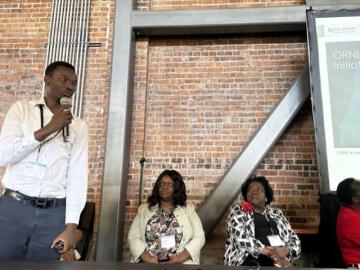
Filter News
Area of Research
News Type
News Topics
- (-) High-Performance Computing (81)
- (-) Neutron Science (82)
- (-) Physics (34)
- 3-D Printing/Advanced Manufacturing (56)
- Advanced Reactors (12)
- Artificial Intelligence (77)
- Big Data (45)
- Bioenergy (68)
- Biology (80)
- Biomedical (42)
- Biotechnology (25)
- Buildings (30)
- Chemical Sciences (35)
- Clean Water (16)
- Composites (11)
- Computer Science (111)
- Coronavirus (19)
- Critical Materials (5)
- Cybersecurity (14)
- Education (2)
- Emergency (3)
- Energy Storage (32)
- Environment (116)
- Exascale Computing (51)
- Fossil Energy (6)
- Frontier (44)
- Fusion (38)
- Grid (32)
- Hydropower (6)
- Isotopes (33)
- ITER (4)
- Machine Learning (37)
- Materials (51)
- Materials Science (55)
- Mathematics (8)
- Mercury (7)
- Microelectronics (3)
- Microscopy (23)
- Molten Salt (2)
- Nanotechnology (17)
- National Security (60)
- Nuclear Energy (66)
- Partnerships (36)
- Polymers (9)
- Quantum Computing (35)
- Quantum Science (48)
- Security (16)
- Simulation (42)
- Software (1)
- Space Exploration (13)
- Statistics (2)
- Summit (40)
- Transportation (30)
Media Contacts

A workshop led by scientists at ORNL sketched a road map toward a longtime goal: development of autonomous, or self-driving, next-generation research laboratories.

Not only did ORNL take home top honors at the 2024 International Conference for High Performance Computing, Networking, Storage, and Analysis (SC24), but the lab’s computing staff also shared career advice and expertise with students eager to enter the world of supercomputing.

Scientists at ORNL are using advanced germanium detectors to explore fundamental questions in nuclear physics, such as the nature of neutrinos and the matter-antimatter imbalance. The ongoing LEGEND project, an international collaboration, aims to discover neutrinoless double beta decay, which could significantly advance the understanding of the universe.

Hugh O’Neill’s lifelong fascination with the complexities of the natural world drives his research at ORNL, where he’s using powerful neutron beams to dive deep into the microscopic realm of biological materials and unlock secrets for better production of domestic biofuels and bioproducts.

Scientists designing the world’s first controlled nuclear fusion power plant, ITER, needed to solve the problem of runaway electrons, negatively charged particles in the soup of matter in the plasma within the tokamak, the magnetic bottle intended to contain the massive energy produced. Simulations performed on Summit, the 200-petaflop supercomputer at ORNL, could offer the first step toward a solution.

Phong Le is a computational hydrologist at ORNL who is putting his skills in hydrology, numerical modeling, machine learning and high-performance computing to work quantifying water-related risks for humans and the environment.

Scientists conducted a groundbreaking study on the genetic data of over half a million U.S. veterans, using tools from the Oak Ridge National Laboratory to analyze 2,068 traits from the Million Veteran Program.

The US focuses on nuclear nonproliferation, and ORNL plays a key role in this mission. The lab conducts advanced research in uranium science, materials analysis and nuclear forensics to detect illicit nuclear activities. Using cutting-edge tools and operational systems, ORNL supports global efforts to reduce nuclear threats by uncovering the history of nuclear materials and providing solutions for uranium removal.

The National Center for Computational Sciences, located at the Department of Energy’s Oak Ridge National Laboratory, made a strong showing at computing conferences this fall. Staff from across the center participated in numerous workshops and invited speaking engagements.

A research collaboration between the Department of Energy’s Oak Ridge National Laboratory and several partner institutions was honored with the Best Event Report award at the 2024 International Conference on Game Jams, Hackathons and Game Creation Events.


